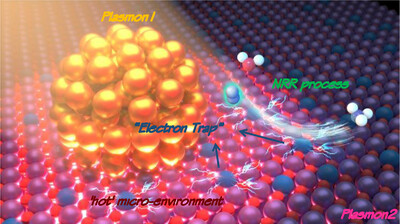
近日,湖南大学王双印团队研究了电子陷阱诱导“热”微环境促进光催化固氮。该项研究成果发表在2025年11月24日出版的《德国应用化学》杂志上。
等离子体光催化旨在构建富含热载流子的高活性表面,以实现氮还原等高能垒化学反应等挑战性过程。在传统体系中,热载流子常因快速热化导致催化效率低下,且其在表面反应中的作用机制复杂且常被忽视。
研究组通过将金纳米颗粒负载于钼掺杂的W18O49纳米棒(Au-MWO-S)上,实现了高效的氮还原产氨,产率达571.0 µmol·h-1·g-1,太阳能-氨转换效率(STA)高达0.28%。通过原位实验与理论模拟发现,MWO-S中的浅能级缺陷作为电子陷阱,可快速捕获、存储并释放热电子,显著抑制其热化。
同时,MWO-S的局域电磁场被增强,在催化剂表面形成高活性的“热”微环境,提高了N2反键轨道的电子占据率,从而大幅提升光催化氮还原反应(pNRR)效率。研究组揭示了热载流子参与表面反应的机制,为开发具有热电子活性表面的催化体系提供了新思路。
附:英文原文
Title: Electron-Trap Induced “Hot” Microenvironment Boosting Photocatalytic Nitrogen Fixation
Author: Bing-Hao Wang, Guang-Hui Chen, Sheng Tian, Huijuan Wang, Yu-Yun Liu, Xiong Wang, Xing-Sheng Hu, Chao Peng, Jin-Xin Li, Yang Li, Li-Long Jiang, Lang Chen, Shuang-Feng Yin
Issue&Volume: 2025-11-24
Abstract: Plasmonic photocatalysis aims to develop a highly reactive surface enriched with hot carriers to enable challenging chemical processes, including high-energy-barrier nitrogen reduction reactions. In traditional plasmonic photocatalysis, hot carriers often undergo rapid thermalization, leading to suboptimal catalytic efficiency. Moreover, the role of hot carriers in surface reactions is often complex and frequently overlooked. Here, we designed a photocatalyst through loading Au nanoparticles on Mo-doped W18O49 nanorods (Au-MWO-S) to achieve efficient nitrogen reduction to produce ammonia, with a formation rate reaching 571.0 μmol h1 g1 and solar-to-ammonia (STA) conversion efficiency up to 0.28%. It was revealed through in situ experiments and theoretical simulations that the shallow energy-level defects in MWO-S act as electron traps to rapidly capture, store, and release hot electrons, which greatly reduces the thermalization of hot electrons. At the same time, the local electromagnetic field of MWO-S was enhanced, creating a high-activity “hot” microenvironment on the surface of the photocatalyst. This, in turn, increased the occupancy of electrons in the anti-bonding orbitals of N2, significantly promoting photocatalytic nitrogen reduction reaction (pNRR). This work unveils the mechanism of hot carrier participation in surface reactions, inspiring the development of catalytic systems with hot-electron-active surfaces.
DOI: 10.1002/anie.202518226
Source: https://onlinelibrary.wiley.com/doi/10.1002/anie.202518226
Angewandte Chemie:《德国应用化学》,创刊于1887年。隶属于德国化学会,最新IF:16.823
官方网址:https://onlinelibrary.wiley.com/journal/15213773
投稿链接:https://www.editorialmanager.com/anie/default.aspx
